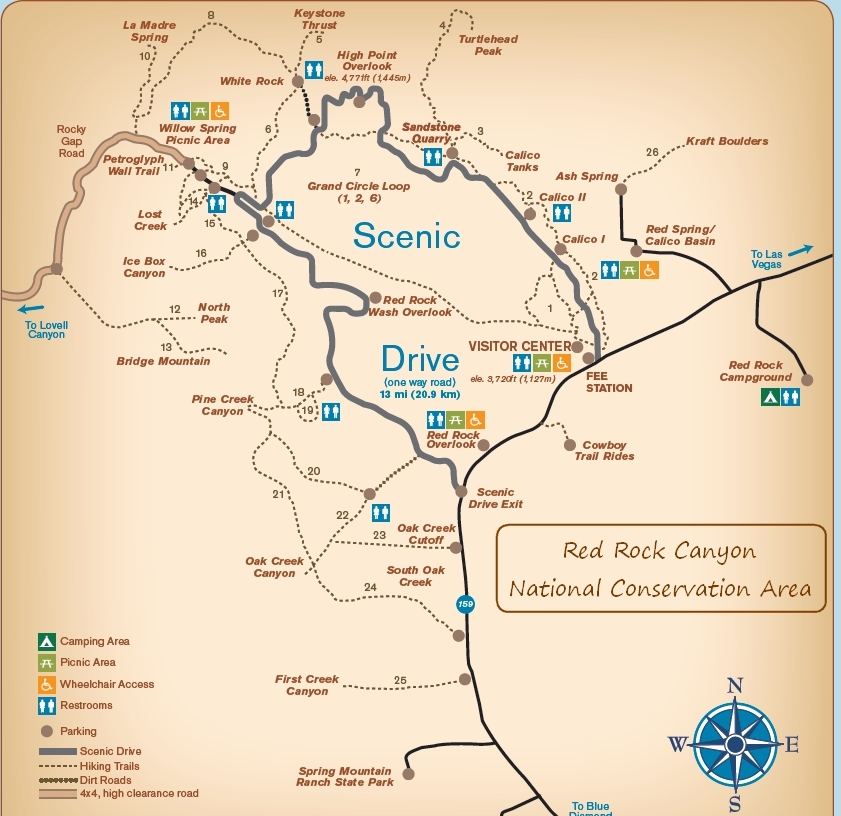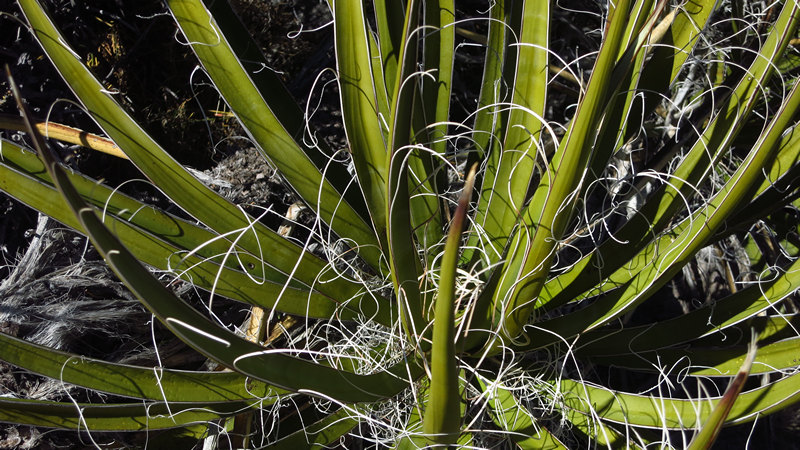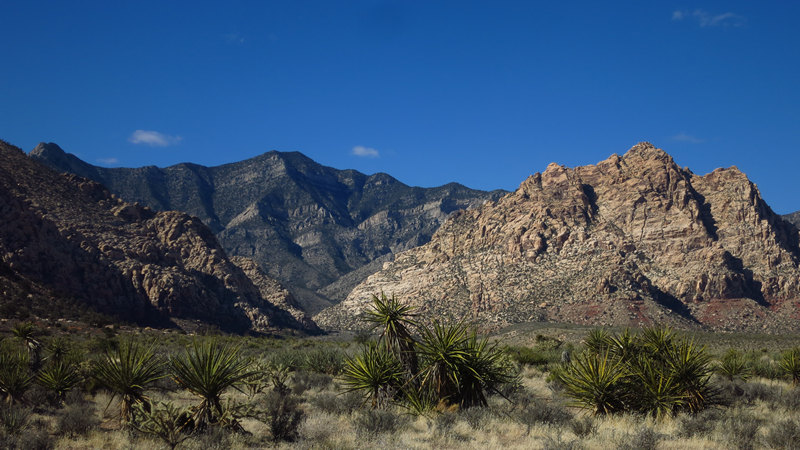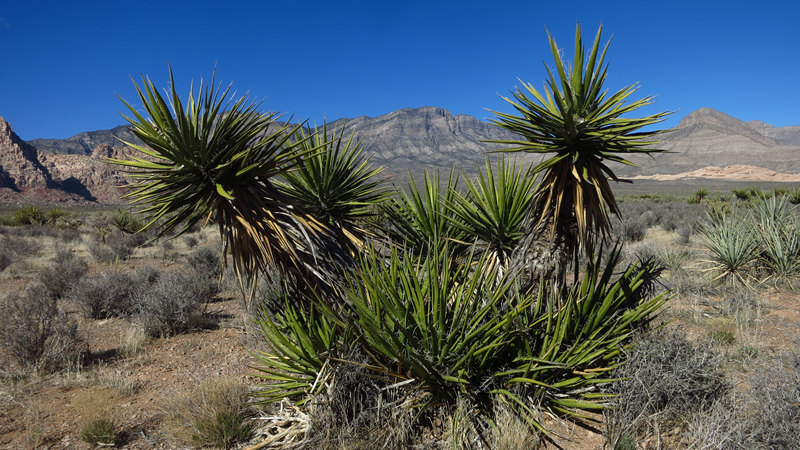Mike Breiding's Epic Road Trips: 20 February ~2018~
Las Vegas Nevada
Keystone Thrust Trail in the Red Rock Canyon National Conservation Area
Limestone, Sandstone and Thrust Faults - Oh my!
Tuesday - 20 February 2018:
Keystone Thrust Trail in the
Red Rock Canyon National Conservation Area
As is usually the case, having fun often gets in the way of writing up my trip logs (TROGs). This TROG was no exception.
To refresh your memory (and mine) this TROG started with an Introduction, followed by my reports on the Kraft Mountain Loop and the Calico Tanks Trail. The latter report I put together on Tuesday morning, working until about 10:30 and then heading out to the Red Rock Canyon National Conservation Area.
I had originally planned to hike the trail to the iconic and nearly always in sight Turtlehead Peak. However, by the time I had the Calico Tanks Trail write up done, got my gear together, and then drove to the trail head it was nearly 11:30.
Knowing Betsy, Donna and Ashok were due late afternoon I realized I would have no time to hike the peak and be back before they arrived at the condo. This being the case I decided to hike the Keystone Thrust Trail instead. At only 2 miles round trip this would allow for a leisurely hike and allow me to be back to the condo in time.

Click on the photos below for a larger image.
As I mentioned, previously I found every parking area clotted with cars and people. Not so for today's hike. Although the parking area was only about a quarter of a mile down a rough and rutted dirt road, this was apparently enough to scare off most people as there were only two cars in the trail head parking lot.
There was an informational sign adjacent to the one shown above which Betsy transcribed for your enjoyment.
Welcome to White Rock. This is a significant area to view the La Madre Mountains. From the starting point, there will be four options for hiking experiences. The two most popular hikes are the White Rock/La Madre Springs Loop and the Keystone Thrust trail. The White Rock/La Madre Springs Loop is wonderfully scenic and diverse. It has rugged mountains, Utah Juniper and pine trees, high vista scenery, and low desert exploration. The length is perfect for a half day adventure. It is a six mile round trip hike with an approximate 900 foot elevation.
The Keystone Thrust trail is short with relatively easy walking. It is rated as a moderate two mile hike with a 400 foot elevation gain. The trail begins with a gentle rise to a tall hill with large boulders to the left. The trail continues to the right and leads to a slightly sloping uphill stairway. The final quarter mile of the trail becomes moderately steep and ventures into the most significant geologic feature of Red Rock Canyon called the Keystone Thrust Fault. The varied rock formations are breathtaking and the colors of the rocks range from white, grey, tan, orange and red.
The Keystone Thrust Fault resulted from a sudden violent upthrust. It was a result of compressional forces deep in the Earth's crust that drove one crustal plate over the top of another. The result was the older gray limestone rocks thrust over the red younger sandstone rocks to form a protective cap. This covering helps to prevent erosion of the sandstone. This geologic wonder is one of the most dramatic and easily identified thrust faults to be found in Las Vegas, Nevada.
Directly in front is a mountain of limestone. To the left are the "White Rocks". And what are they composed of? I could find no information about their composition which seemed odd to me considering the amount of geology info which is online.
Here is Turtlehead Peak which dominates the landscape. Layed out at the base of the peak are the deceptively miniscule looking Calico Hills.
A closer look at "the Calicos".
Here we have a close look at the Mojave yucca (Yucca schidigera) which is common in this area of the southwest. Note the many twisted strands of fibrous material.
The fibers of the Yucca schidigera leaves were used by Native Americans to make rope, sandals, and cloth. The flowers and fruit could be eaten and the black seeds were ground into a flour. The roots were used to make soap.
Some reports claim that Native Americans washed their hair with yucca to fight dandruff and hair loss. Among the other maladies this yucca has been used to treat are headaches, bleeding, gonorrhea, arthritis and rheumatism.
Source: WikiPedia
And what exactly are the long strands of fibers called? This I have not been able to find out. I am sure the plant morphologists have a unique name for them but I was unable to find this out via several Google searches. If you know what they are called please email me.
Yucca have many uses some of which are described on the Primitive Ways website.
It seems everywhere I hike there is evidence of fire. The old Juniper was one of many casualties.
It was at this point the peace and quiet I had so far enjoyed came to an end. First it was the barking of two dogs which a couple had with them. Then it was the miserable whining and complaining of a young boy who the parents could not or would not control.
I would like to say this is a rarity when I hike, but that would be a lie.
I love the austere beauty of these dry landscapes as much as I love the nearly tropical lushness of the Appalachian forests. I would not want to do without either.
Here we are at the turn around point which gives a commanding view of Turtlehead and the Calicos.
!! WARNING !!
I am not a geologist.
I have no training in geology whatsoever.
I have no formal education beyond the 8th grade.
Any comments, observations or statements made herein concerning geology should be verified by a Professional Geologist.
OK. What about the "Limestone, Sandstone and Thrust Faults - Oh my!" part.
According to professional geologists the limestone shown here (grey color) is older than the sandstone (reddish color). This means the limestone should be under the sandstone. But it is not. Why not?
My interpretation of the info I have read is simplistically stated here:
At one time the sandstone was on top of the limestone.
Then there was a cataclysmic event which forced the limestone (older) on top of the sandstone (newer). For my simple mind this gets complicated real fast. Fortunately there are folks out there who can help people like us and provide a relatively simple and easy to understand explanation. For me to understand these types of events graphics always help.
Those graphics are provided on a web page I am affectionately going to call "Thrust Faults for Dummies". Here is that explanation. "Something Awesome: Keystone Thrust Fault".
For a textual explanation the following may help. Or, it may confuse you further.
A “thrust fault” is a break in the Earth's crust from squeezing or compression; the block of crust on one side of the fault block moving up the fault plane and overtopping the block on the other side of the fault. Adjacent to the red sandstone Calico Hills in the Red Rock Canyon of Nevada, lies a spectacular example of a thrust fault, the Keystone Thrust. Here 500 million year old limestone rests on 180 million year old sandstone, forming Turtlehead Peak, pictured above.
At the time the thrust fault occurred, the crust here consisted of 180 million year old red and tan sandstone overtopping 500 million year old limestone and dolomite. These layers formed from sandy and calcareous deposits in shallow seas. About 65 million years ago, this crust was compressed causing an oblique fault. A block of sandstone and underlying limestone was thrust on top of a similar block, causing an alternating mountain of sandstone on limestone on sandstone on limestone. Over the next several million years, the upper sandstone was exposed to the elements and eroded away, leaving older limestone (500 million years old) atop younger sandstone (180 million years old), the Keystone Thrust. Photo taken on April 5, 2006.
So, there you have it. My version of "Thrust Faults for Dummies".
On my way back along the Red Rock Canyon Scenic Drive I stopped to take a few snaps of these Buckhorn Cholla (Cylindropuntia acanthocarpa) and the gorgeous landscape in which they reside.
Chollas have cylindrical stems, in contrast to the flattened stems of the Opuntia. However, chollas are similar to prickly pears in many ways, including their jointed stems, possession of glochids, and seeds with hard outer protective surfaces (arils).
Source: Cholla Web © 2018
The stunning scenery shown here and below are why so many people travel here to enjoy the Red Rock Canyon National Conservation Area.
The last shot of the day and then it was back to the condo. If memory serves, Betsy, Donna and Ashok arrived about 3:30. Once they got settled we had our happy hour and then walked down the street to "Steiner's-A Nevada Style Pub".
As soon as we walked into the place we smelled cigarette smoke. When we inquired about a non smoking section we were led to the right side of the large, open bar and dining area. It was then we realized the smoking section was in the bar area not far from the no smoking section. What a joke. It was non smoking but is was certainly not smoke free.
I cannot remember what Donna and Ashok ordered but Betsy and I shared a large bowl of good old spaghetti. It was actually pretty tasty with a distinctive tasting sauce.
Then it was back to the condo and early to bed as usual but not before checking the weather forecast for the next day. It was to be in the 20s overnight in the Red Rocks with highs in the 40s, partly cloudy and windy on the following day. This cold snap came on the heels of months of sunny weather in the 60s. Luckily we all had many warm layers to take the chill off.
See you later for another hike in the Red Rocks.











